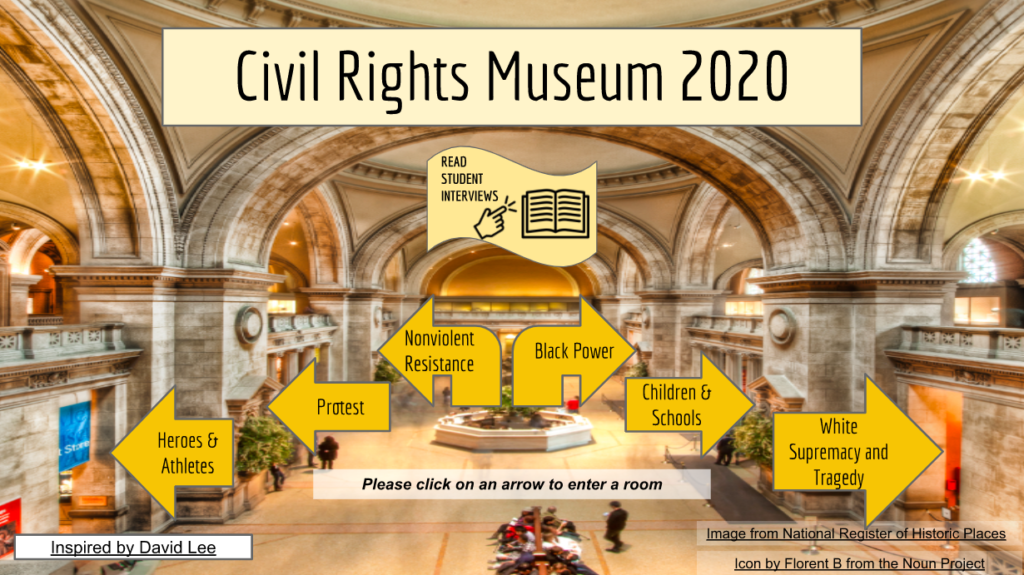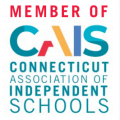The Civil Rights Project is a long-standing tradition in 8th-grade social studies. In years past, students have created mostly low-tech projects with both handmade visuals and an oral presentation. They shared their knowledge with family, faculty, peers, and community members during an on-campus Civil Rights Day. Picture a fair-like setting in which visitors visit and listen to individual students’ presentations throughout the ALC. The setting was busy, noisy, and full of positive energy.
This year with the pandemic, we did not have the option of gathering together with our community, so we had to create another way. Thanks to our collaboration with our Academic Technology Coordinator, Tom Gromak, the middle school history and English teachers — including Anna Alferi, Ann Haggerty and myself — were able to create a virtual civil rights museum to house student projects and presentations. What we had thought was going to limit us actually ended up freeing us to explore new ways to learn and share.
After conducting in-depth research on their topics, students created and photographed a variety of artifacts to exhibit in our museum ranging from a 3D-printed lithophane to LEGO creations to dioramas and models to paintings. They harnessed their research, creativity, and interests to express the significance of their topics and studied examples of authentic museum labels to write their own.
Because they could not deliver live oral presentations this year, students created screencast presentations to share their research instead. After much revision, practice, and several recordings, students added their screencasts to their virtual exhibits for their visitors to experience. The synthesis of research, analysis, oral presentation, creativity, and technology resulted in a powerful publishable museum for our community.
As with every skill, we had a range of experience in and excitement about the digital format. As the students saw their beautiful work come together, they were super proud of what they had accomplished and most think we should keep this format for future years. Most notable is that Tom believes, “This assignment had great layering of learning. Yes, they learned about the civil rights era, but layered on top of that, our entire grade has thought deeply about how to present digitally in a permanent exhibition, they learned how to screencast (after doing multiple takes), and they learned how to photograph a 3D object for display. They will now have these tools for the rest of their lives which will be a benefit to their educational, professional and personal lives.”
The other major difference in our projects this year was the interdisciplinary collaboration between the English, social studies, and technology departments. Traditionally through social studies class, students interviewed community or family members about their memories of the Civil Rights Era and compiled their oral history essays into a book. This year, students read The Other Wes Moore by Wes Moore, which is an autoethnography of Moore’s childhood stories told alongside social historical information. Students then took this form of writing when interviewing family and community members, and later composed an essay on the experiences of those they interviewed who lived through the Civil Rights Era. The resulting oral history collection, a virtual book, is another stop in our museum. Through the exploration of civil rights through the lenses of several disciplines, students could arrive at a deeper and more holistic understanding of the material and had ample opportunity to build their skills in a variety of areas. Colleague Ann Haggerty commented, “After working so intensively with students on their individual topics in social studies, I was blown away when I read their interviews, such honest attempts to connect with others in this personal way and to apply the concepts learned in The Other Wes Moore, the Civil Rights Project, and our study of current events.”
The interdisciplinary approach to this year’s civil rights projects allowed our students to take a deep dive into the history of and present-day connections to America’s Civil Rights Era. Given all that is transpiring in our country and our world and the unfinished work around equality and justice ahead of us, I am grateful for the opportunities our students have to explore and create around the theme of civil rights.
I like the beauty of the museum collection as a whole. It assembled so well as an entire museum while showcasing each student’s unique contribution. I also appreciated the revision process that had to take place while we created a polished product for our community. A lot of learning occurred in between the students’ multiple drafts. Finally, I am glad that anyone in our community is welcome to visit our museum anytime and take all the time they’d like to absorb and appreciate the efforts of our students. That would not be the case if we met live on campus for a short period of time.
Our students never cease to impress me with how well they think and how deeply they care; they give me hope for a better future.



